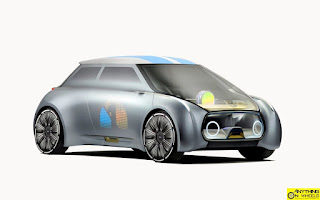One hundred years. That's quite a milestone to survive. BMW Group has did just that and are celebrating their centenary with bold concepts predicting the next 100 years. While we saw BMW's vision of a car of the next century earlier this year, it is time now to look at what Rolls-Royce and Mini think of themselves a hundred years from now!
Named the 'Vision Next 100 Concept' just like its BMW sibling, Rolls-Royce's prediction of its future car looks bonkers. Its either distinctively futuristic or downright ridiculous and nothing in between. The big trapezoidal grille with the 'Spirit of Ecstasy' proudly on top and the long hood are just like the ones we see in Rolls-Royce motor cars today but that's where the similarity ends. The pinched fascia, the hidden wheels, the sloping roofline and the whole car itself tries too hard to look different. While no details are released, an electric drivetrain is said to be the mode of propulsion. Of course, its autonomous and does away with the need for a driver's seat and even the steering wheel. With just a plush sofa in there and a big OLED screen in front, this is literally a lounge on wheels.
Rolls-Royce says the Vision Next 100 Concept is a culmination of what Rolls-Royce patrons could expect from their car in the coming decades and the brand's own vision of how to meet those expectations. We bet those said patrons didn't see what was coming when they gave their inputs! Personal Vision, Effortless Journey, The Grand Sanctuary and The Grand Arrival are said to be the key tenets of this future vision from Rolls-Royce. Whatever they call it, we think its just too weird and polarizing!
Mini played its part and contributed to the centenary celebrations with its vision of a car of the next century. And quite unlike the Rolls-Royce, the Mini Vision Next 100 Concept looks a lot like the current Mini. The classic silhouette, the heavy floating roof, the circular headlamps and the lean greenhouse atop a wide lower half are all there, just a bit modernized and tuned to the future.
Mini predicts the future would be car-sharing and to ensure the car is adaptable to those driving it, Mini has made the car a blank canvas that responds and changes to the individual user. Thankfully, Mini thinks humans will still like to drive as often as possible. So there is a steering wheel that can be slid in the space between the driver and the co-passenger if the occupants wish to switch to autonomous driving. A central circular instrument that's so typical of the Minis of today finds its place in the cabin. Its cheekily called a 'Cooperizer' and acts as a link between the driver and the car's digital intelligence. As expected, a zero-emission electric drive system is said to be sitting underneath that diminutive shell.
Now that we are done with seeing how BMW, Rolls-Royce and Mini envision them 100 years from now, let's see what BMW Motorrad has in store later this year!



















